A 15-components versatile keyer and powerful PSU modulator for the EMTX

PC keyer and AM modulator
A 15-components versatile keyer and powerful PSU modulator for the EMTX

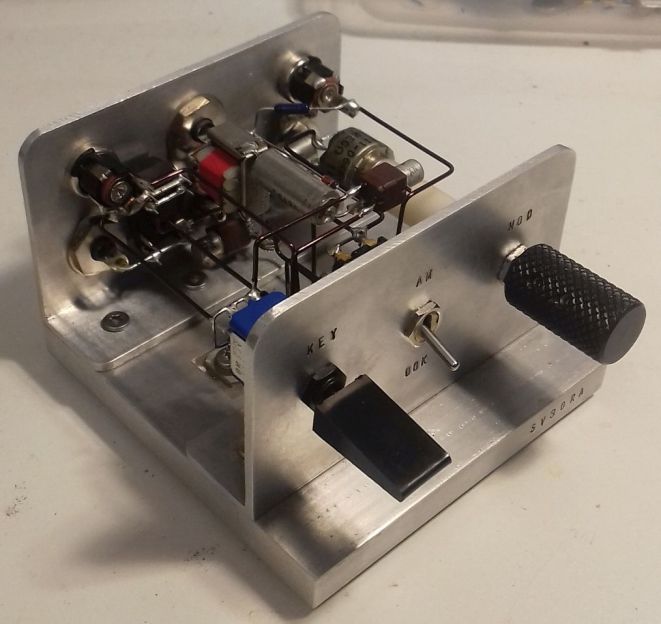
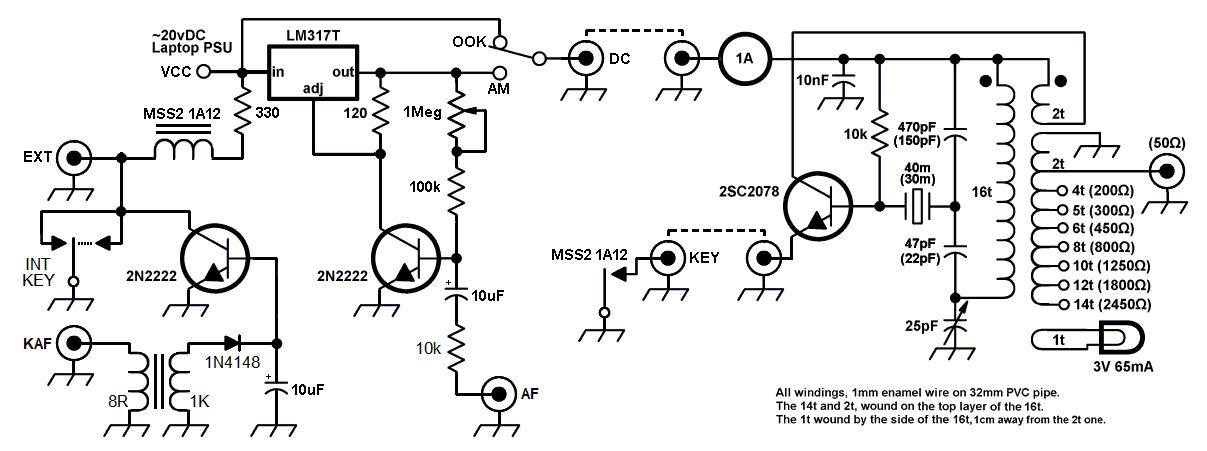
Above: Schematic of the keyer and modulator (on the left) for the EMTX. The EMTX schematic is shown as well on the right, to determine the connections to the keyer/modulator.
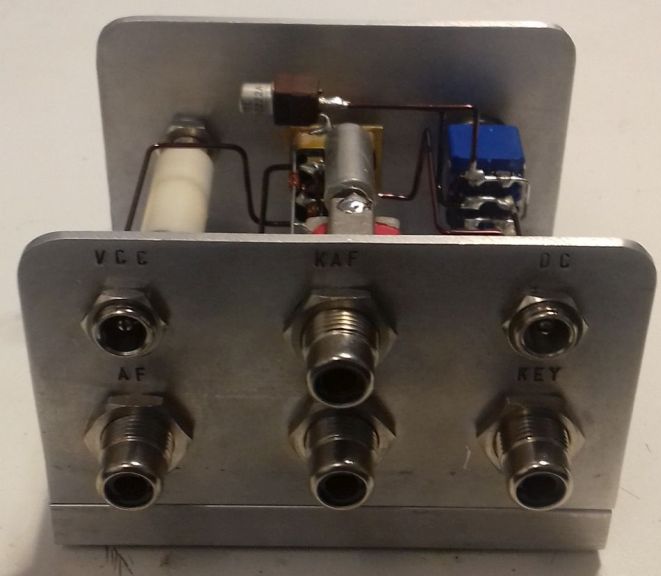
Above: Back connections to the EMTX.
Below: Pictures of the finished keyer/modulator. You don't have to build it that nice-looking if you don't
care.
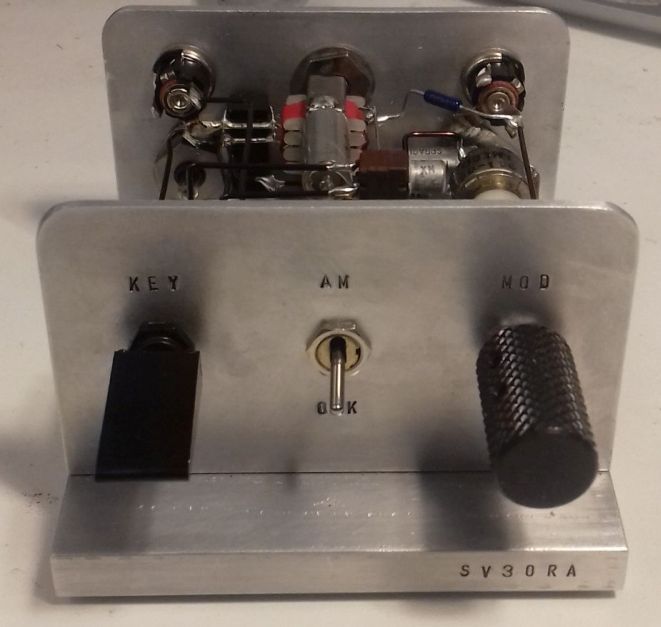
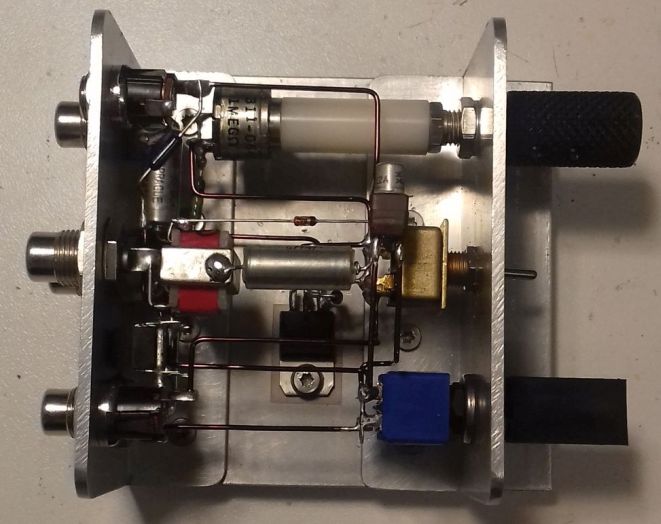
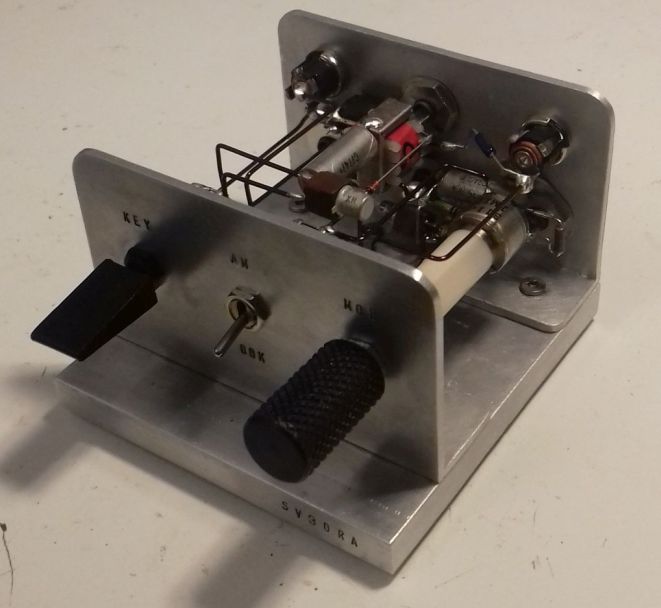
Below: modulator prototype and EMTX built on a breadboard. Yes it worked just fine
onto a piece of wood.
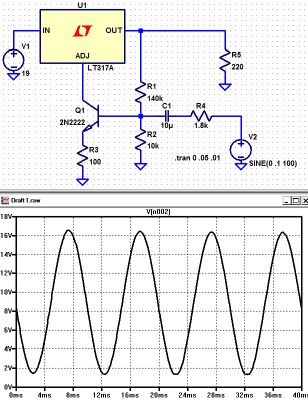
His simulated circuit is a slight variation (for measurement purposes). The
resistor to ground on the base stabilizes the bias and the ratio of R1
and R2 set the output voltage (0.6 volts across R2 gives about 8 volts
across R1). He put in an emitter resistor just for good measure. Same
for the series resistor from the source. Charles words, "I don't know
how believable these results are but it looks pretty darned good!".
The circuit is being used as a current booster, the current being the
supply to the transmitter and dependent on the voltage it produces. The
LM317 always tries to keep 1.25V between it's output pin and "adj" pin
but where we benefit here is the current at the "adj" pin is very low,
so it is easier to apply audio to it. Effectively, the error amplifier
inside the voltage regulator is used as an additional amplifier stage.
The output pin voltage varies according to the voltage on the "adj" pin
so if we use it to bias the transistor we get negative feedback which
improves the quality of the modulation. More output voltage = more bias
current = lower output voltage. The result, is a very cheap, low
components-count, very sensitive AM modulator that can supply lots of
power to easily drive the transmitter and produce a clean and deep AM
modulation!
The
AM modulator bias is set with the 1M potentiometer. Depended on the
bias level, the idle carrier on the EMTX can be set from about 0.5W all
the way up to 8W. Needless to say that this modulator can modulate any similar power transmitter, not just the EMTX.
The keyer
If
it is to modulate the EMTX
from the PC, so as to use the different digital modes, there must be a
way to key it also from the PC. This
is why I decided to embed into the same circuit, a PC keyer which is
triggered by the line audio of the PC, but also triggered manually
(internal or external key). Keying by audio tones was
decided, because modern PCs do not have LPT ports to trigger directly
by DC. This keyer uses a reed relay to reliably, fastly and scilently
key the EMTX, which is activated by a transistor. The base current for
the transistor is derived from the audio signal after rectification.
The incoming audio from the PC line passes through the mini audio
transformer to increase its voltage, it is rectified and then charges
the shunt capacitor to drive the base of the transistor. The keyer
"speed" (decay) is determined by the shunt capacitor size. The circuit
starts to trigger from about 50-60% of my sound card output signal
level.
The relay used to key the EMTX, must be able to tolerate at least 1A of switching and carrying current. Note that the relay contacts switching current is not the same as the contacts carrying
current. Reed relays are the best especially if you want long relay
life, noiseless operation and very fast switching speeds, like the ones
used in Hellshreiber. If you can't find such a relay, you can use a
reed switch capable of 1A of switching and carrying current and then
place a suitable electromagnet close to it, so you can build the relay
yourself. If you do so, find the best point where the reed switch
responds to the electromagnet.
The keyer relay must be as close as possible to the emitter of the transistor used in the EMTX. The connectors at the back of the EMTX and the keyer/modulator have been physically placed so that when the two units are side by side, a very short link cable is required for this purpose. With the two devices placed close together, you can now use any length of cable for your manual external key, which is now connected to the "EXT" connector of the keyer/modulator.
The
keyer does also have an internal mini straight key.
I find this idea very nice, to avoid extra cables. It is not the most
convenient key in the world, but it is there along with the transmitter
every time you need it. By using a special pannel switch from apem,
I was able to tripple this switch usage for the different modes of the
keyer. The vinyl lever cap you see in the next picture, is the original
part of the switch, to make it easier to key with your finger. But you
may build such a part on your own, to fit on other switches types.
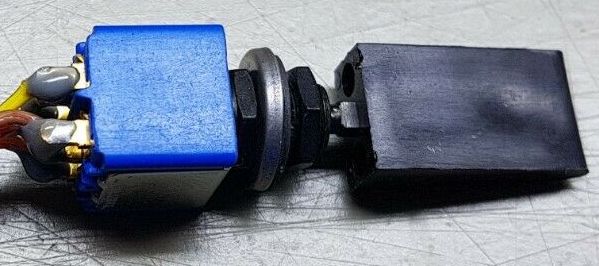
The
switch is an ON-OFF-(ON momentary) switch type. In the default (middle)
position, only the PC keying action is activated. In the top position
(ON), the keyer is always active, which is useful for broadcasting
audio (into a dummy load). The bottom (ON momentary) position, is the
manual PTT action. This is used as a straight key on OOK operation, or
as a PTT on AM voice operation. Simple and effective!
Initially,
I used one channel of the PC sound card for triggering the keyer and
also as an AF signal for the AM modulator, but this caused several
problems of unreliable keying or distortion. So I decided to use a second separate AF
input (KAF) to key the keyer. This second input, uses the other channel
of the stereo sound card. With the addition of this input, there is no
interaction between the keyer and the modulator. The AF levels that the
keyer and the modulator require, can be set independently. Instead
of adding more hardware for the purpose, I have chosen to set these
levels by adjusting the volume and the balance of the sound card, which
works great. Also, programs like Fldigi, have options for using one of the
two channels of the stereo sound card as a keying interface (PTT
channel), which makes the keying efen more reliable. When the program is in transmit mode, a continuous tone is
heard on the PTT channel. This steady tone, is used by the keyer as a
reliable keying signal, independent of the audio signal of the digital
mode that modulates the modulator. This solution works very reliably
for any mode. But
if the program you are using does not have an option for a PTT channel,
that is ok, as the keyer works reliably even without this feature. For
voice communication or broadcasting music (into a dummy load) you just
use the internal key switch as a PTT to handle these modes.
Results
Prior to building the keyer and the modulator in the same device, I had tested the circuits independently quite a few times, to ensure the results can be reproduced. The modulation quality and depth out of the AM modulator have to be listenned to be believed. I have not made any linearity measurements, I just trust my ears on this one. It works great on music as well as on voice. Apart from that, this is the most sensitive AM modulator I have ever built, requiring only a small fraction of the line level output of the PC sound card.
When modulated by this modulator, the EMTX
shows no audible signs of FM modulation. I switched my receiver to SSB
and I could perfectly zero beat the AM modulated music signal which
stayed on frequency and it's tone did not change during loud audio
signal music. Switching back and forth from SSB to AM modulation on the
receiver, I did not notice any difference in the audio quality, apart
of course from the narrower bandwidth on SSB modulation, due to the
narrower IF filter inside the receiver on SSB.
The
AM/OOK switch is used to select the modulation applied to the EMTX. When the keyer is set to be triggered by audio from the PC,
at
the OOK position, the EMTX is just switched on and off by the audio
tones
applied to the keyer, or by the manual key, internal or external
(connected to the "EXT"
connector). At AM position, the EMTX is switched on by the audio signal
applied to the KAF connector and at the same time
AM modulated by whatever audio signal is applied to the AF connector.
On voice communications, the momentary position of the internal key is
used as a PTT. On music broadcasting (into a dummy load) the
non-momentary position of the internal key is used to keep the keyer
always active.